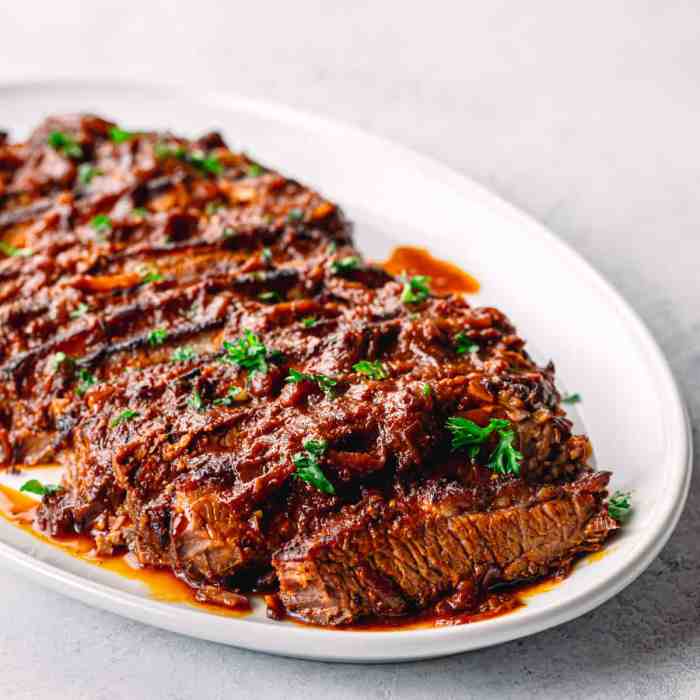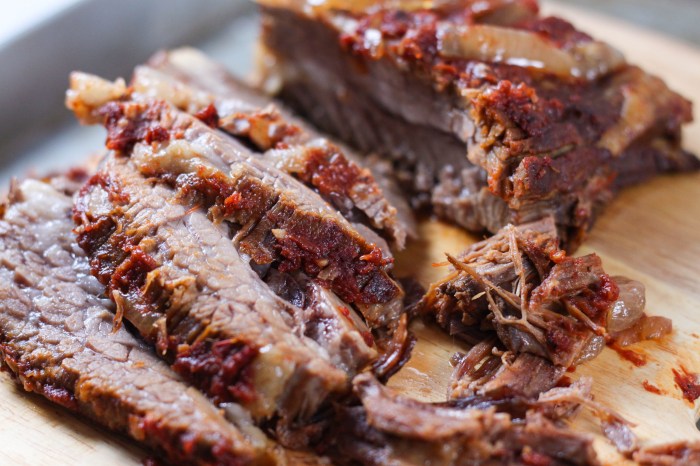Beef Brisket and Cranberry Sauce: A Culinary Harmony: Beef Brisket Cranberry Sauce Recipe
Beef brisket cranberry sauce recipe – The pairing of savory beef brisket and sweet-tart cranberry sauce is a classic combination, particularly prominent in American cuisine during the holiday season. This seemingly simple pairing offers a delightful complexity, showcasing the beautiful balance between sweet and savory flavors. This article will explore the history, preparation, and presentation of this delectable dish, offering insights into achieving the perfect culinary harmony.
A Brief History and Flavor Profiles
Beef brisket, a cut from the breast of beef, has a rich history, often associated with economical cuts of meat transformed into tender delicacies through slow cooking methods. Its inherent fattiness and connective tissues lend themselves beautifully to long cooking times, resulting in melt-in-your-mouth tenderness. Cranberry sauce, on the other hand, boasts a history deeply rooted in Native American traditions, later embraced by European settlers and becoming a staple in American cuisine, especially during Thanksgiving.
The tartness of cranberries provides a delightful counterpoint to the richness of the beef, creating a balanced flavor profile.
The sweet and savory interplay is key to this dish’s success. The richness of the brisket, often enhanced by smoky or savory seasonings, finds its perfect complement in the bright acidity and sweetness of the cranberry sauce. This contrast isn’t just about taste; it’s about texture too. The tender, juicy brisket contrasts beautifully with the burst of slightly tart, jewel-toned cranberry sauce.
Recipe Variations: Navigating the Sweet and Savory Spectrum
Cranberry sauce recipes vary widely, ranging from intensely sweet to refreshingly tart. Some recipes rely heavily on sugar, creating a syrupy sauce that complements the richness of the brisket. Others emphasize the natural tartness of the cranberries, incorporating less sugar and perhaps a touch of orange zest or spices for complexity. A spicy cranberry sauce adds another dimension, offering a fiery kick that cuts through the richness of the beef.
Here’s a recipe for a spicy cranberry sauce:
- 1 (12-ounce) bag fresh cranberries
- 1 cup orange juice
- ½ cup maple syrup
- 1 jalapeño pepper, finely minced (remove seeds for less heat)
- ½ teaspoon ground cinnamon
- ¼ teaspoon ground cloves
Combine all ingredients in a saucepan. Bring to a boil, then reduce heat and simmer until cranberries burst and sauce thickens (about 10-15 minutes).
Three methods for preparing cranberry sauce include stovetop (as described above), slow cooker (combine ingredients in slow cooker and cook on low for 4-6 hours), and oven (combine ingredients in a baking dish and bake at 375°F for 30-40 minutes).
Mastering Beef Brisket Preparation
Achieving a tender, flavorful brisket requires careful preparation and cooking. Trimming excess fat is crucial, but leaving a thin layer helps retain moisture during cooking. Seasoning generously with salt, pepper, and your preferred spices is essential for developing a flavorful bark. Different cooking methods yield different results.
A delicious beef brisket cranberry sauce recipe often benefits from a complementary glaze. For a smoky sweetness, consider incorporating elements from a fantastic bar b que sauce recipe , perhaps using a reduced version to enhance the brisket’s flavor profile without overpowering the cranberry’s tartness. The result is a beautifully balanced and flavorful dish.
- Smoking: This low-and-slow method, typically using wood chips, imparts a deep smoky flavor and incredible tenderness. It requires patience and monitoring of temperature.
- Slow Cooking: A slow cooker or Dutch oven provides a moist cooking environment, resulting in a tender brisket. This method is less hands-on than smoking.
- Braising: This involves searing the brisket before slow cooking in liquid, resulting in a rich, flavorful outcome.
To achieve a perfect bark, ensure the brisket is properly seasoned and cooked at a low temperature for an extended period, allowing the sugars and spices to caramelize.
Ingredient Selection and Substitutions
The type of cranberry used significantly impacts the sauce’s flavor. Fresh cranberries offer the brightest, most vibrant flavor. Dried cranberries add intensity, while canned cranberries offer convenience but may lack the same vibrancy. Substitutions for sugar include maple syrup, honey, or agave nectar. Spices like ginger, allspice, or star anise can be added for flavor complexity.
| Ingredient | Quantity (per serving) | Calories (approx.) | Sugar (approx.) |
|---|---|---|---|
| Fresh Cranberries | 1/4 cup | 25 | 4g |
| Sugar (granulated) | 1 tbsp | 45 | 12g |
| Orange Juice | 2 tbsp | 10 | 2g |
| Beef Brisket (cooked) | 4 oz | 200 | 0g |
Serving Suggestions and Presentation, Beef brisket cranberry sauce recipe

Source: tasteofhome.com
Beef brisket and cranberry sauce are incredibly versatile. Serve the brisket sliced thinly, alongside creamy mashed potatoes, roasted root vegetables, or crusty bread. The cranberry sauce can be served alongside or spooned directly onto the brisket. Plating should be visually appealing, perhaps arranging the brisket slices artfully on a platter, with a dollop of cranberry sauce alongside. Garnishes like fresh herbs (rosemary, thyme) or toasted pecans add visual interest and flavor.
The ideal serving temperature for the brisket is warm, but not hot, allowing the flavors to fully develop. The cranberry sauce should be slightly thickened, yet still retain a pleasant texture.
Troubleshooting Common Issues

Source: poshjournal.com
Dry brisket is a common problem, often caused by insufficient fat or overcooking. Ensure proper trimming and use a meat thermometer to avoid overcooking. A too-thin cranberry sauce can be thickened by simmering it longer. Leftovers can be stored in airtight containers in the refrigerator for up to 4 days.
Visual Guide: The Perfect Brisket and Cranberry Sauce

Source: farmwifecooks.com
A perfectly cooked beef brisket exhibits a deep reddish-brown color, with a rich, dark bark that is slightly cracked and glistening. The meat itself should be incredibly tender, pulling apart easily with a fork, and the texture should be moist and juicy, not dry or tough. Imagine the rich, mahogany hue of the bark, punctuated by the glistening fat rendered during cooking.
The meat beneath should appear reddish-pink, tender, and ready to melt in your mouth.
The ideal cranberry sauce boasts a deep, vibrant red color with a glossy sheen. Its texture should be slightly thickened, yet not overly stiff or syrupy. Imagine a bowl filled with plump, glistening cranberries, each one coated in a luscious, translucent sauce. The color is rich and jewel-toned, and the overall appearance is inviting and appetizing. The texture is smooth and slightly chunky, indicating a perfect balance of cooked cranberries and a thickened sauce.
Question & Answer Hub
Can I use frozen cranberries?
Yes, frozen cranberries can be used, but you may need to adjust cooking time slightly as they contain more moisture. Thaw them completely before using.
How long can I store leftovers?
Leftovers can be stored in an airtight container in the refrigerator for up to 4 days.
What if my brisket is too dry?
Ensure sufficient fat coverage on the brisket before cooking. Consider using a meat thermometer to avoid overcooking. You can also add a bit of broth or liquid to the cooking process to keep it moist.
What are some alternative sweeteners for the cranberry sauce?
Maple syrup, brown sugar, or honey can be used as alternatives to granulated sugar, depending on your desired level of sweetness and flavor profile.
